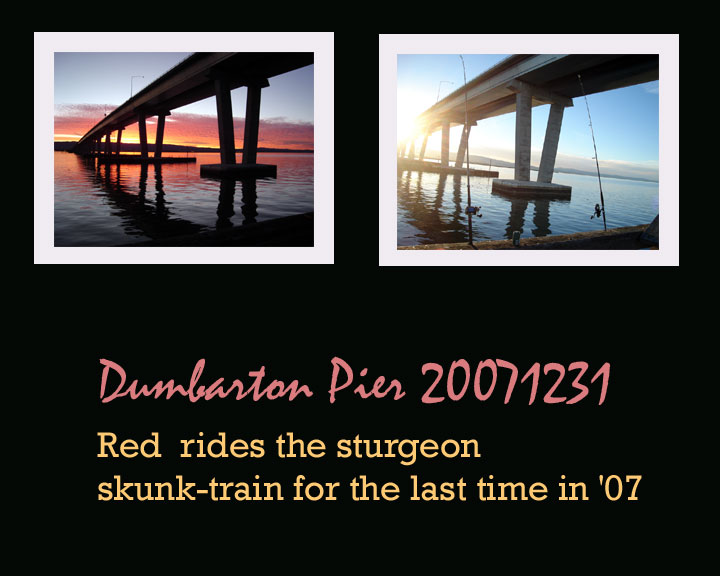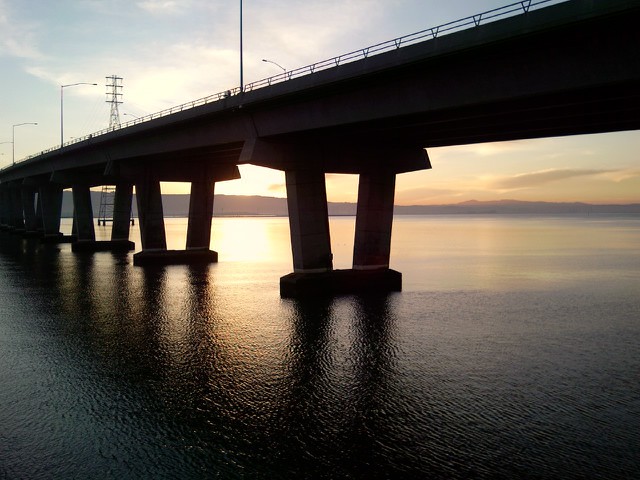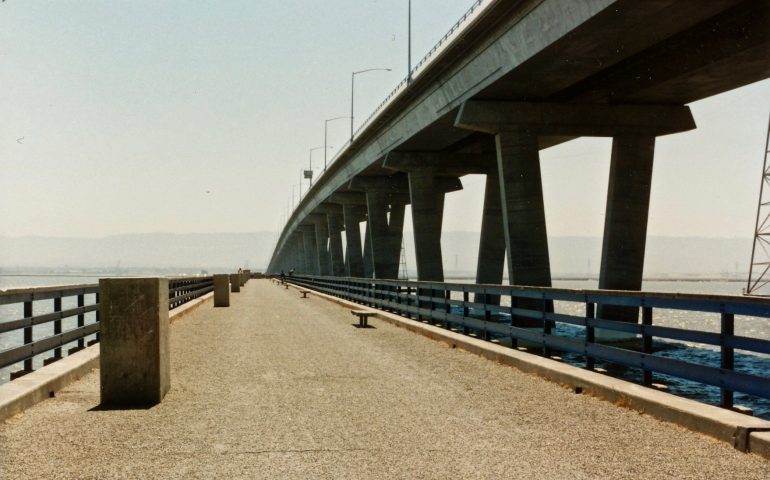
Date: March 14, 2008; To: PFIC Message Board; From: pierrat80; Subject: Dumbarton Pier
I fished from 6:30am to about 3:00pm with ghost shrimp for one small Leo @ 24″ or so. I had a couple more bites through out the day, most likely sharks. People been telling me that at least a sturgeon a day has been caught out there for the last few weeks, but I have yet to hook in to one. Bad luck or something. Oh, about 9:00am I looked over the railing of the pier, and there were millions of red things swimming in the water; I figured it was some type of shrimp. I dropped my net down to see what they were and it was a swarm of small bloodworms. Bloodworms for sure ‘cuz one of the little buggers bit me. It was crazy, never seen or heard of anything like it. Riding the current in little bait ball style. Well it lasted for about an hour. I just have to say, the pier in the morning is great. Everybody out there is very respectful, and polite. No one really crowds you or fishes on top of you. Afternoons… a whole different story.
<*}}}}}}}}}>< — As expected, fish surveys conducted by the California Department of Fish and Game between 2004 and 2009 did not show as many different species as some piers but they did show a couple of interesting stats. The fish (numerically) — barred surfperch, white croaker (kingfish), leopard shark, bat ray, seven gill shark, striped bass, white sturgeon, brown smoothhound shark, black perch, diamond turbot and starry flounder. Interesting that this south San Francisco Bay pier showed barred surfperch as the greatest number of fish but no calico or redtail surfperch were recorded. Some piers in the northern part of San Francisco Bay show calico and redtail surfperch but no barred surfperch. Interesting too was the high number of seven gill sharks, the highest recorded at any pier.
<*}}}}}}}}}>< — Another interesting list of local fish was seen in a newspaper editorial in 1969.
Voice of the People
Editor: Some of your readers may be interested in learning of the different species of fish that inhabit south San Francisco Bay. The state Department of Fish and Game issued a report based on sample collections of fish caught in the Bay during the years from 1953 through 1966.
The report states that the following fish were caught in the vicinity of the Dumbarton Bridge: anchovy, striped bass, croaker, flounder, goby, herring, lamprey, midshipman, perch (no rubberlip perch however), pipefish, ray, rockfish, sanddab, sculpin, shad, shark (brown smoothhound, leopard, sevengill and spiny dogfish), skate, smelt, sole, stickleback, tomcod and tonguefish.
The four most common fish caught in 1966, in order of size of catch, were the anchovy, perch, smelt and herring. The report notes, “On April 24, 1964, feeding schools of anchovies south of the Dumbarton Bridge were estimated to contain several tons of fish. Several times an anchovy haul was over 1,000 pounds, and could not be hauled aboard the trawler.
It was also noted that a small run of steelhead passes through this area to San Francisquito Creek in Palo Alto, and also, in each of the four years this area produced more fish than the Bay opposite Oakland Airport and south of the San Mateo Bridge.
—Fremont Argus, November 20, 1969
<*}}}}}}}}}>< — Special Bay Area Regulations:
- A perch closure exits in San Francisco and San Pablo Bay from April 1 to July 31. No perch may be kept other than shinerperch (20).
- In San Francisco and San Pablo Bay a fishing line may not contain more than three hooks.
Sturgeon Regulations:
- A sturgeon report card and tags are required for anyone fishing for or taking sturgeon. (a) The card must be in the angler’s possession; (b) a tag must be used for any sturgeon retained by the angler; (c) the angler must record information on the Sturgeon Report Card immediately after catching and keeping or releasing the sturgeon.
- White sturgeon can only be kept from 40-60 inches; larger and smaller sturgeon must be released.
- Green sturgeon may not be taken or possessed.
History Note. This area has an interesting history. The name Dumbarton Point itself apparently dates to 1876 when it was named after the town Dumbarton, Scotland. About the same time, Origin Mowry established a successful landing on the deep slough just south of Dumbarton Point.
Railroads also played a part in the growth of the area when the narrow-gauge Santa Clara Valley Railroad was bought by James Fair, James Flood and Alfred “Hog” Davis. They renamed the line the South Pacific Coast Railroad, extended the railroad from Dumbarton Point to Santa Cruz, and eventually offered daily commute service north to the Alameda Pier. In addition, people could catch the railroad’s ferryNewark, which ran daily trips from Dumbarton Point to San Francisco. Eventually that railroad was bought by Southern Pacific and this area became one of the busiest freight junctions in California.
The original “Dumbarton Bridge” was the Dumbarton Cutoff Railroad Trestle Bridge. The train bridge was constructed between 1908 and 1909 at the shallow part of the bay between Dumbarton Point and the Palo Alto area. It was the first bridge across the bay and carried six to eight freight trains daily between 1910 and 1982.
However, the real “Dumbarton Bridge,” the one that served as the precursor to today’s Dumbarton Bridge—and this pier—was an iconic bridge that opened on January 15, 1927. It was the first bridge to allow automobiles to cross San Francisco Bay and was, until 1929 when the San Mateo Bridge opened, the longest highway bridge in the world. Unfortunately, the bridge was only two lanes wide, was built close to the water, and was a drawbridge. As with most drawbridges, long backups in traffic could occur when a boat decided to travel under the bridge. It was also a toll bridge with users paying the grand sum 40¢ each way.
Built by private funds (the Dumbarton Bridge Company), the bridge was partially rebuilt in the 1940s to deal with increased traffic. In 1951 the state bought the bridge for$2.26 million dollars.
By the ‘60s, it was obvious that the old bridge needing either an expansion or needed to be rebuilt as a larger bridge. The latter option proved more feasible and in the ‘70s the state began planning a new bridge.
In December 1984 a new Dumbarton Bridge opened (at a cost of 74 million dollars), one that was four lanes wide and high off the water. The bottlenecks seemed at an end. Users now paid a toll 75¢ to help defray the costs of the bridge.
In 1989, as a result of the temporary closing of the San Francisco—Oakland Bay Bridge (due to the Loma Prieta earthquake), the bridge was restriped to accommodate six lanes of traffic. Unfortunately the widening of the approaches wasn’t completed until July 2003 (at a cost of $200 million); one result was new traffic congestion, especially during rush hours. The toll, westbound only, as of 2010 was $5.
Although the middle section of the old bridge was blown up in 1984, farsighted individuals had seen a use for both end sections. The eastern end of the bridge became the Dumbarton Fishing Pier, the western end became the Ravenswood Fishing Pier.
Looking back, many wharves and piers dotted the South Bay during the second half of the 19th Century. One was near the mouth of Alameda Creek where, in 1850, John Horner bought land and built several piers and warehouses; eventually the area became Union City.

Dumbarton Pier Facts
Hours: Open daily from 6 a.m. to 8:30 p.m. except for Thanksgiving, Christmas and New Years. The road to the pier is closed from April 1 to August 31 but a free shuttle runs from the Visitor Center to the pier at 9 a.m. and 12:30 p.m. The shuttle picks up returning anglers at 12:45 and 5:15. Reservations for the shuttle are advised (510-792-4275).
Facilities: Free parking is located at the foot of the pier. Portable toilets will be found at several spots on the pier. Fish cleaning stations, benches and windbreaks are found on the pier. There are no facilities for bait and tackle or food.
Handicapped Facilities: None specifically although the pier’s surface is blacktop and easily used by wheelchair. The railing is approximately 42 inches high.
How To Get There: From I880 take Highway 84 west to the Paseo Padre Parkway exit; follow the exit and road south back under the highway, the road will turn into Thornton Avenue; follow it till you see the signs on your right indicating both the visitor center for the wildlife refuge and the pier; after entering the refuge, follow the road three miles to the pier.
Management: U.S. Department of the Interior/Fish and Wildlife Service.

I think the hours need to be updated. It’s sunrise to sunset now. Also, I don’t observed any road closure these days, I’ll double check.
“Striped Bass – 2006” is Nick “The Informative Fisherman” from a fairly popular You Tube Bay Area fishing show.